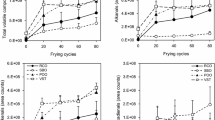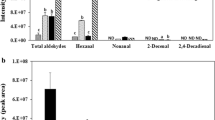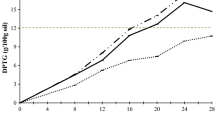Abstract
The behavior of crude Sclerocarya birrea kernel oil (SCO) and Sorghum bug (Agonoscelis pubescens) oil (SBO) during deep-frying of par-fried potatoes was studied with regard to chemical, physical, and sensory parameters, such as content of FFA, tocopherols, polar compounds, oligomer TG, volatile compounds, oxidative stability, and total oxidation (TOTOX) value. Palm olein was used for comparison. Whereas potatoes fried in SCO that had been used for 24 h of deep-frying at 175°C were still suitable for human consumption, potatoes prepared in SBO that had been used for 6 to 12 h were not, considering the sensory evaluation. In looking at the chemical and physical parameters, SBO exceeded the limits, after no later than 18 h of use, for the amount of polar compounds, oligomer TG, and FFA recommended by the German Society of Fat Sciences (DGF) as criteria for the rejection of used frying oils. In contrast to SBO, SCO oil did not exceed the limits for the content of polar compounds and oligomer TG during the frying experiment. Only the amount of FFA was exceeded; this was because the amount of FFA at the beginning of the experiment was higher than for refined oils. The results showed that both oils were suitable for deep-frying of potatoes, but remarkable differences in the time during which both oils produced palatable products were found.
Similar content being viewed by others
References
U.N. Food and Agriculture Organization, Traditional Food Plants, Paper No. 42, FAO Food and Nutrition, U.N., Rome, 1988.
Mizrahi, Y., and A. Nerd, New Crops as a Possible Solution for the Troubled Israeli Export Market, in Progress in New Crops, edited by J. Janick, ASHS Press, Alexandria, Virginia, 1996, pp. 37–45.
Salama, R.B., The Seed Oil of Sclerocarya birrea, Sudan J. Food Sci. Technol. 5:4–6 (1973).
Ogbobe, O., Physico-Chemical Composition and Characterization of the Seed and Seed Oil of Sclerocarya birrea, Plant Foods Hum. Nutr. 42:201–206 (1992).
Mariod, A.A., A.O. Ali, S.A. Elhussein, and I.H. Hussien, A Reinvestigation of Physicochemical Characteristics and Fatty Acid Composition of Sclerocarya birrea (homeid) Kernel Oil, Sudan J. Sci. Technol. 6:178–183 (2005).
Mariod, A.A., B. Matthäus, and K. Eichner, Fatty Acid, Tocopherol and Sterol Composition as Well as Oxidative Stability of Three Unusual Sudanese Oils, J. Food Lipids 11:179–189 (2004).
Lalas, S., and V. Dourtoglou, Use of Rosemary Extract in Preventing Oxidation During Deep-Fat Frying of Potato Chips, J. Am. Oil Chem. Soc. 80:579–583 (2003).
Chang, S.S., R.J. Peterson, C. Ho, S.S. Chang, R.J. Peterson, and C. Ho, Chemical Reactions Involved in the Deep-Fat Frying of Foods, Ibid. 55:718–727 (1978).
Xu, X.-Q., V.H. Tran, M. Palmer, K. White, and P. Salisbury, Chemical and Physical Analyses and Sensory Evaluation of Six Deep-Frying Oils, Ibid. 76:1091–1099 (1999).
Przybylski, R., and R.C. Zambiazi, Predicting Oxidative Stability of Vegetable Oils Using Neural Network System and Endogenous Oil Composition, Ibid. 77:925–930 (2000).
Official Methods and Recommended Practices of the American Oil Chemists' Society, 4th edn., AOCS Press Champaign, Illinois, 1993.
Deutsche Gesellschalt für Fettewissenschaft (DGF), Deutsche Einheitsmethoden zur Untersuchung von Fetten, Fettprodukten, Tensiden und verwandten Stoffen, Wissenschaftliche Verlagsgesellschaft, Stuttgart, Germany, 1998.
Balz, M., E. Schulte, and H.P. Their, Trennung von Tocopherol und Tocotrienolen durch HPLC, Fat Sci. Technol. 94:209–213 (1992).
Metrohm, Oxidationsstabilität von Ölen und Fetten—Rancimatmethode, Herisau, Switzerland, Application Bulletin Nr. 204/1 d (1994).
Statgraphics®, Statgraphics Statistical Graphics Systems, version 4.0. STSC Inc., Rockville, Maryland, 1985–1989.
Recommendations of the 3rd International Symposium on Deep Fat Frying—Optimal Operation, Eur. J. Lipid Sci. Technol. 102:594 (2000).
Kiritsakis, A.K., Flavor Components of Olive Oil, J. Am. Oil Chem. Soc. 75:673–681 (1998).
Kao, J., E.G. Hammond, and P.J. White, Volatile Compounds Produced During Deodorization of Soybean Oil and Their Flavor Significance, Ibid. 75:1103–1107 (1998).
Warner, K., P. Orr, and M. Glynn, Effect of Fatty Acid Composition of Oils on Flavor and Stability of Fried Foods, Ibid. 74:347–356 (1997).
Stevenson, S.G., M. Vaisey-Genser, and N.A.M. Eskin, Quality Control in the Use of Deep Frying Oils, Ibid. 61:1102–1108 (1984).
Gasparoli, A., The Formation of New Compounds, Grasas Aceites 49:303–309 (1998).
Kiatsrichart, S., M.S. Brewer, K.R. Cadwallader, and W.E. Artz, Pan-Frying Stability of NuSun Oil, a Mid-oleic Sunflower Oil, J. Am. Oil Chem. Soc. 80:479–483 (2003).
Che Man, Y.B., and W.R. Hussin, Comparison of the Frying Performance of Refined, Bleached and Deodorized Palm Olein and Coconut Oil, J. Food Lipids 5:197–210 (1998).
Gertz, C., Chemical and Physical Parameters as Quality Indicators of Used Frying Fat, Eur. J. Lipid Sci. Technol. 102:566–572 (2000).
Augustin, M.A., and S.K. Berry, Efficacy of the Antioxidants BHA and BHT in Palm Olein During Heating and Frying, J. Am. Oil Chem. Soc. 60:1520–1522 (1983).
Fritsch, C.W., Measurements of Frying Fat Deterioration, Ibid. 55:718–727 (1981).
Boskou, D., Frying Temperatures and Minor Constituents of Oils and Fats, Grasas Aceites 49:326–330 (1998).
Wagner, K., and I. Elmadfa (1999) Nutrient Antioxidants and Stability of Frying Oils: Tocochromanols, β-Carotene, Phylloquinone, Ubiquinone, in Frying of Food: Oxidation, Nutrient and Nonnutrient Antioxidants, Biologically Active Compounds and High Temperatures, edited by D. Boskou and I. Elmadfa, Technomic Publishing, Lancaster, Basel, 1999, pp. 165–167.
Tsaknis, J., V. Spiliotis, S. Lalas, V. Gergis, and V. Dourtoglou, Quality Changes of Moringa oleifera, Variety Mbololo of Kenya, Seed Oil During Frying, Grasas Aceites 50:37–48 (1999).
Author information
Authors and Affiliations
Corresponding author
About this article
Cite this article
Mariod, A., Matthäus, B., Eichner, K. et al. Frying quality and oxidative stability of two unconventional oils. J Am Oil Chem Soc 83, 529–538 (2006). https://doi.org/10.1007/s11746-006-1236-5
Received:
Accepted:
Issue Date:
DOI: https://doi.org/10.1007/s11746-006-1236-5




